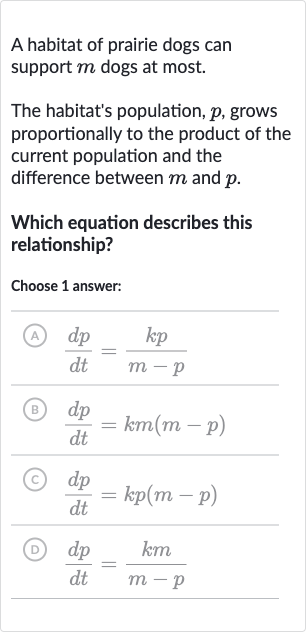AI tutor
Full solution
Q. A habitat of prairie dogs can support dogs at most.The habitat's population, , grows proportionally to the product of the current population and the difference between and .Which equation describes this relationship?Choose answer:(A) (B) (C) (D)
- Population Growth Rate Equation: The growth rate of the population is proportional to the current population and the difference between the maximum population and the current population .
- Proportional Relationship: The proportional relationship can be expressed as , where is the proportionality constant.
- Option (A) Analysis: Looking at the options, we need to find the one that matches our proportional relationship.
- Option (B) Analysis: Option (A) doesn't match because it divides by instead of multiplying.
- Option (C) Analysis: Option (B) doesn't match because it multiplies by , which is not the same as .
- Option (D) Analysis: Option (C) matches our proportional relationship exactly.
- Option (D) Analysis: Option (C) matches our proportional relationship exactly.Option (D) doesn't match because it divides by instead of multiplying by .
More problems from Write a linear function: word problems
QuestionGet tutor help
QuestionGet tutor help
QuestionGet tutor help
QuestionGet tutor help
QuestionGet tutor help
QuestionGet tutor help
QuestionGet tutor help
QuestionGet tutor help
QuestionGet tutor help

